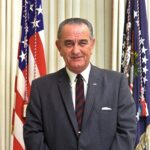Lyndon Baines Johnson was born on August 27, 1908. He was an American politician who served as the 36th President of the United States from 1963 to 1969 and was often referred to by his initials L.B.J. He had previously served as President John F. Kennedy’s 37th vice president from 1961 to 1963. Johnson was a Democrat from Texas who served as a representative, senator, and senate majority leader. He has the distinction of being one of the few presidents who have served in every elected federal post. Let’s celebrate this important personality right here.
Fast Facts
Full Name:
Lyndon Baines Johnson
Nickname:
L.B.J.
Birth date:
August 27, 1908
Death date:
January 22, 1973
Age:
64 years, 4 months
Zodiac Sign:
Virgo
Height:
6' 4"
Background
Lyndon Baines Johnson was born in Stonewall, Texas, on August 27, 1908. Samuel Ealy Johnson Jr. and Rebekah Baines were his parents. He had three sisters and a brother, and was the oldest of his siblings. At the age of 15, he graduated from Johnson City High School in 1924. He then went to San Marcos’ Southwest Texas State Teachers College. Following his graduation, he began a teaching career and also entered politics. Johnson was voted speaker of “Little Congress,” a group of Congressional assistants, in 1931, after Congressman Richard M. Kleberg appointed him as his legislative secretary. He was named director of the Texas National Youth Administration in 1935. He won a special election for Texas’s 10th congressional district a couple of years later and served in the House from April 1937 until January 1949. During WWII, he also served in the United States Naval Reserve. In 1941, he was commissioned as a lieutenant commander and deployed to the South Pacific.Republicans secured a majority of votes in both the House and Senate in the 1952 general election. Johnson, a Democrat, was elected minority leader by his colleagues in 1953 becoming the Senate’s youngest minority leader ever. The Democrats took control the following year, and Johnson became the majority leader. He was nominated for vice president by the Democrats in 1960, to run alongside presidential nominee John F. Kennedy. The Kennedy-Johnson ticket narrowly defeated Republican nominee Richard Nixon in the election. On January 20, 1961, Johnson was sworn in as vice president of the United States.President John F. Kennedy was killed in Dallas, Texas on November 22, 1963. Within hours following Kennedy’s death, Johnson took the presidential oath. After the death of John F. Kennedy, he became president at a moment when the country was in shock and grief. In the 1964 presidential election, Johnson ran as an independent candidate. His campaign revolved around his vision of a “Great Society.” He advocated for educational reforms, improved medical treatment, and improvements in the lives of the financially underprivileged and the elderly. Against Republican presidential contender Barry Goldwater and his vice presidential running mate William E. Miller, he and his vice presidential running mate Hubert Humphrey won the election. Johnson was sworn in as president for the second time. Johnson signed numerous acts as President in an attempt to establish the ‘Great Society.’ As part of the fight against poverty, the Economic Opportunity Act was passed. He also enacted laws that established programs like Head Start, Food Stamps, and Work-Study. These laws benefited a large number of Americans, and the poverty rate decreased.Johnson was popular and was expected to run for re-election in 1968. After standing down as president on January 20, 1969, he shook the nation by revealing that he would not run for another term and retiring to his ranch. In November 1934, he married Claudia Alta “Lady Bird” Taylor. They had two daughters together. During the last several months of his life, Johnson was ill and had cardiac problems. On January 22, 1973, he died at his Texas ranch after suffering a cardiac arrest.
Career timeline
Johnson serves as a U.S. Senator from Texas.
The Civil Rights Act of 1964 is signed into law by Johnson on July 2.
The Tax Reduction Act achieved its goals of increasing personal incomes, consumption, and capital investments across the nation.
Johnson serves as a member of the U.S. House of Representatives.
Johnson wins the presidential election, defeating the Republican nominee Barry Goldwater by a landslide with 61.05%.
On August 6, Johnson signs into law the Voting Rights Act of 1965.
Johnson is posthumously awarded the ‘Presidential Medal of Freedom.’
Lyndon B. Johnson FAQs
How did L.B.J. make his money?
The basis of the family fortune was a small radio station, KTBC, in Austin, which the Johnsons bought in 1943.
Was Lyndon Johnson a Republican?
No, he was a Democrat.
How many years did Lyndon B. Johnson serve as president?
He served for six years.
5 Surprising Facts
-
He was a teacher
He was a teacher at a school around the border of Mexico.
-
He was nearly killed in W.W.2.
During the war, he served in the Naval Reserves and was later given the Silver Star for his bravery.
-
He almost died as a senator
He had a heart attack while he was in the Senate, which didn't stop him from working from his sickbed.
-
He held four significant positions
He had a great political portfolio with four distinguished offices: a representative, senate majority leader, vice president, and president.
-
He followed his father’s footsteps
His father was a Texas state representative and an ardent politician himself.
Why We Love Lyndon B. Johnson
-
He fought against poverty
The comprehensive social-welfare legislation introduced by the Johnson administration was dubbed the "War on Poverty." Johnson asked Congress in his first State of the Union address in January 1964 to launch an "unconditional war on poverty." He signed the Economic Opportunity Act of 1964, which came to define the War on Poverty, into law on August 20, 1964.
-
He made education accessible
Johnson prioritized education because he believed that education was the key to overcoming illiteracy and poverty. In 1965, Congress approved the Elementary and Secondary Education Act (ESEA). It was a comprehensive law that provided funding for basic and secondary education. It placed a strong emphasis on equal access to education while also establishing high standards and accountability.
-
He improved the economy
Following Kennedy's assassination, Johnson prioritized approval of the tax-cut bill. The bill was passed, and Johnson signed the Revenue Act of 1964 into law on February 26, 1964. The Tax Cuts and Jobs Act achieved its objectives of increasing personal earnings, consumption, and capital investments while substantially reducing unemployment.
Lyndon B. Johnson’s birthday dates
| Year | Date | Day |
|---|---|---|
| 2023 | August 27 | Sunday |
| 2024 | August 27 | Tuesday |
| 2025 | August 27 | Wednesday |
| 2026 | August 27 | Thursday |
| 2027 | August 27 | Friday |













